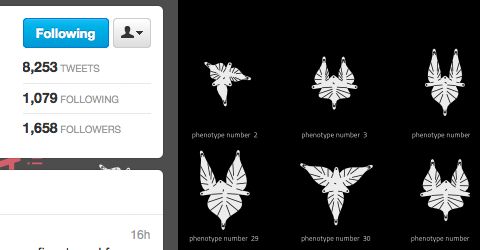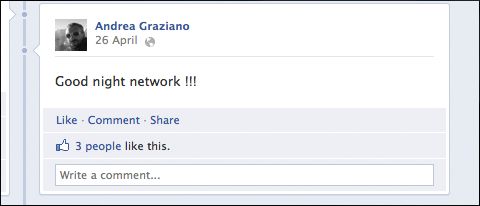I started this blog in November 2009. Initially very few people knew, and for many months only 10 people a day would come visit. Then on April 3rd, 2010, a man in Italy posted a link on Twitter that said: "Digital Morphogenesis – Easter eggs". Overnight hundreds of people had followed the link, and they in turn made more connections, weaving this once isolated blog into the much larger 'network'.

The traffic spike from Andrea’s first connection, followed by spikes from subsequent connections
That first connection had a pretty profound impact on me. For one thing I now know the man in Italy is Andrea Graziano. He is a supernode in a network of people sharing new information about computational design. Whereas a few years ago I would struggle to find information on computational design in book and journals, now I just have to open my Twitter and Facebook to see this flowing network of new knowledge. It is like my own newspaper - tailored for my very niche niche (perhaps not coincidentally I have given up reading the real newspaper and no longer have a TV). Yet for all that Andrea shares, for all the impact he has on my information diet, I realised I know very little about him. So I asked him some questions. Ordinarily I would cut the interview down to 1000 words but Andrea's answers are so interesting, so provocatively full of hope, I have kept them all.
This might seem like a silly question, but like many others I only know you from your links, so what were you doing before you became famous on the Internet?
A: OMG, am I famous?? I was, and I am, an architect. I have a small architectural practice near Turin (Italy) dealing with construction drawings for big buildings. My digital networking activity is something that started some years ago with my DigitAG& blog. It’s a passion that I always do for free in my spare time, although actually it takes more and more time … making me now a sort of Dr. Jekyll & Mr. Hyde... half my day spent as a standard practicing architect … half my day spent as one of the many web-nodes in the architectural research community and also as a Co-de-iT member. It’s very hard to maintain these two activities but it’s also my attempt to try to join my practice work with computational research, a big challenge – especially in Italy.

What motivated you to start sharing on Twitter, Facebook, G+ (ect.)?
A: Well ... I started my Facebook adventure because I wanted to connect all the friends and colleagues from my DigitAG& blog. I was looking for a way to talk and exchange ideas more fluidly, so Facebook was a natural evolution of the blog. Moreover I always used the blog to post links closely related to architectural research … but many of the interesting things that I saw everyday were about other science fields, or art, or nature, etc. So I started to use Facebook as a complementary flow of links. In fact I think that 80% of my complementary flow goes through my social network profiles. Then someone suggested that I use Twitter because it’s used more by the scientific community. So I started using Twitter and lately also Google+.
I think the main reason I continue my sharing activity via social networks is that our work as computational designers makes no sense if, on the other side, people are unable to understand what we are doing. We are designers of processes … not shapes … so only by explaining our methods and our “cultural paradigm” we can give sense to our work and give it value – both economically and conceptually. So my way to help spread the emerging paradigm of complexity is by using the social networks … and after some years of “networking” I can say that it works in some way. A lot of friends have started doing it also, and are posting interesting links everyday. The best feedback is receiving new friend requests and new followers.

Do you notice any differences in terms of engagement from your readers on different platforms (eg. G+ vs Facebook) and what is your favorite platform?
A: Yes … surely. The main difference is the mode of friend/follower aggregation. Facebook is a network that grows via friendships … so it grows via friends that are told about me and so on. Twitter is completely different. It works via hashtags … you can find anyone interested in the same thing by typing a hashtag. So the Twitter network grows around specific interests, resulting in a more focused network. Google+ combines the best parts of both, leading me to better know some of my Twitter digi-friends. I find G+ the most interesting platform or maybe, with the experience, I have learned to add and receive the more interesting connections.
I think that my network activity reveals a lot about network behaviors … I post everyday the same links over the three networks (actually 4 including Scoop.it) The different feedback presents an ongoing experiment. There are several aspects of the reader feedback that need to be underlined. Facebook is sometimes a real mess of links …. the flow of messages is a mix of songs, personal stuff, photos and sometimes interesting links … but on the other hand it enables easy replying, with connected links. Another advantage is that it’s the older one … so more people are into this network and maybe it’s the more colloquial … so I still really like it and I use it as my main platform. Another interesting thing is the effectiveness of links based on the time they were posted. There are some hours that are better for sending out news and letting it spread. I know, it can seem odd, but using networks for a long time you start to develop some network senses and attitudes also. Trying to resume … I think that … yes, the three networks let me know different people in different ways but at the end what really matters is that I know very interesting people in each one.

Often you end the day by saying 'goodnight network' - who are the network?
A: The more I live in this network, and more I think that the comparison of the web to a global brain, it’s totally true. We are each a digital neuron, able to spread digital signals called links, which are pieces of information that joined together give collective ideas and through collective “muscles” and “bodies” become physical words. I have started to read and learn more about brain structure, function, and complexity. In addition to being fascinated, I have found that using similar strategies as the brain, the web reacts as the brain. So maybe this is part of the reason I call us a network … I’m a node that spread more links, and triggers more thoughts and other node reactions. I think that for the young generation it is strategic to understand and learn about network complexity in order to take a position in the world as citizens and workers. Thus at the end of the day, after having spent a lot of hours flowing in this flux of digital stimuli, I really like to quit my connection saying “goodnight network” … it’s a way to say we are part of a great and unique being.

About a year ago I saw Helen Castle (editor of AD) give a lecture, she was boasting about how AD was the first to feature Archigram back in the 60's. I couldn't help feeling that had Archigram emerged in 2012, AD would be the last place to run the story. And then I see Patrik Schumacher on Facebook essentially bypassing the magazines and blogs by going straight to his audience. How do you see the architectural discussion evolving in the future?
A: The architectural discussion is evolving due to the social networks but especially due to the culture of sharing that social media spreads and promotes. Everyday, more and more architectural research is available for free on the web. Everyone can easily find, share, and promote interesting research. With this knowledge visible, learning is going to be easier for those who have the passion and motivation.
But I think the main difference comes from doing architecture. The big challenge is always to build architecture. Only by doing can we fail and learn from our errors, share our experience with others and contribute to the evolution of the architectural discussion. Sincerely I don't believe about new “isms”. In the end we are bringing to architecture, with a delay compared to other science fields, the “complexity paradigm”. The world around us is deeply changing and architecture has to face this. We are moving rapidly from a serialized economy to a customized and personalized one. Machines for production are everyday cheaper and accessible. Innovation is moving from big companies to garages. The young generations are introducing novelty and bringing this complexity paradigm to their research and experiments, which is deeply affecting the architectural evolution and discussion. I don’t think social networks are, or will be, the main places for the architectural discussions. They are tools to reach, meet and know very interesting people. A way to have a direct connection with people, readers, followers, and a way to get some direct and interesting feedback. A great online community of researchers, designers, architects is emerging, but its real value is in the potential to trigger connections.
And finally, who do you follow?
A: At the start of 2012 I did a blog post wishing to everyone a 'Good Network' and I listed all my preferred nodes. I must say that during this last year I have shifted my attention from architectural stuff to a wider range of interests - mostly due to my friends links and posts. In the next few years, architecture - as everything - will be more and more influenced by other disciplines of knowledge. We are moving to nanoscale matter design, printed materials, self-track everything, ubiquitous computing, an era where information will be the foundation of digital and physical matter. Opening our minds to this new world is the best thing we can do … so be wild in your interests, follow your passions.

Thank you to Andrea for taking the time to answer these questions. You can find Andrea in many parts of the network:
- DigitAG& - http://andreagraziano.blogspot.com/
- Co-de-iT - http://www.co-de-it.com/
- Twitter - http://twitter.com/digitag
- Facebook - http://www.facebook.com/arch.a.graziano
- Google+ - http://gplus.to/digitag
- Twitter wall - http://www.twylah.com/digitag
- Scoop.it - http://www.scoop.it/t/digitag-journal
Sivam krish
Andrea does such an amazingly good job bringing all kinds of interesting things around design to our attention. He supplies most of my weekly viewing list. I find all his pointers extremely interesting.
Thanks Andrea for sharing them.